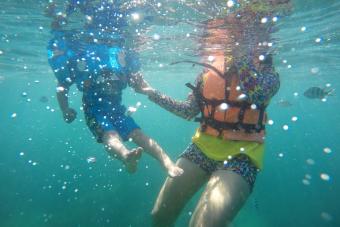
Swimming is not only a great physical exercise for toddlers, it's also proven to improve mental health, enhance family relationships, and provide consistent mood benefits. While splashing around the pool looks appealing to little ones, you might be overwhelmed with the options in swim equipment for your child. From the toddler's first dip to more water-based adventures, complete his gear with good, pool-ready swim aids.
Safety First Buoyancy Aids
Building your child's confidence in the water is your number one goal in teaching him how to swim and the best swim aid for any toddler is an adult swim buddy. For a toddler to be receptive to learning, the first step is to make him feel safe while exploring the water world. If you choose to use a swim aid for safety, the American Academy of Pediatrics and American Red Cross recommend only using U.S. Coast Guard approved life jackets, life vests, or personal flotation devices.
- Type I life jackets are best for offshore excursions with potential for rough waters.
- Type II life jackets are best for calm, inland waters.
- Type III life jackets are floatation aids most commonly used in pools.
Stearns Puddle Jumper Toddler Life Jacket/Vest
While most kids resist swim vests because they are too restrictive around the neck, the Stearns Puddle Jumper® Life Jacket provides a simple solution. Children for Children lists this fun option in their Top 10 Best Life Jackets for Kids because of its durability, cute designs, adjustable fit, and comfortable fit. Their Puddle Jumper Infant Life Jacket has a slightly different design to work as a flotation device for babies up to 30 lbs. The toddler version is:
- For kids weighing between 30 to 50 lbs and costs about $30
- Recommended for use in pools and calm lakes
- A U.S. Coast Guard-approved toddler floatation device that fits comfortably in the chest without constricting the neck of the toddler thanks to the design
- Loved by parents because it keeps their kids upright in the water and the arm pieces allow for free movement while keeping the child secured

Full Throttle Child Water Buddy Life Jacket/Vest
For safety purposes when boating or out in rougher water like oceans, a life jacket with an easy grab handle is ideal. The Full Throttle Child Water Buddies vest fits kids who weigh between 30 and 50 pounds.
- Each vest features a toddler-friendly theme like dinosaurs or ladybugs and costs about $35.
- The back of the vest is a rounded foam shape that helps right your toddler on their back.
- With a zippered front, waist belts, and leg strap you can get the perfect fit for your little one.
This U.S. Coast Guard approved Type III Life Jacket is the number one pick for toddler life jackets from Life Jacket Pro because of its versatility in different water environments.
Learn to Swim Tube Trainer
Providing a full 360-degree floatation, the Learn-to-Swim™ Tube Trainer from POOLMASTER® is a unique, heavy-duty, 20-gauge vinyl air-filled tube encased in a polyester fabric and worth its price at less than $25. Parents highly recommend this product with an average of 4.5 out of 5 stars.
- The tube trainer is composed of a ring buoy and a tank-top swim vest with security anchor strap between the legs to keep it in place. It permits the toddler to paddle freely, float upright, and practice front or back swimming.
- POOLMASTER® provides detailed tube trainer instructions on how to inflate, deflate, wash, and wear the swimming aid.
- You can adjust the amount of inflation gradually once your toddler shows independence in the water.
- It has an ultraviolet protection factor (UPF) 50 for added sun protection.
Splash About Float Suit
A smart alternative to swim belts and life jackets to keep your toddler safe at the surface of the water while swimming, are float suits. The uniquely shaped float panels are adjustable and evenly spaced around the child's core to fit comfortably around his body and help your toddler become a more independent swimmer. As your child becomes more adept in the water, the floats can be detached one by one.
The Splash About Float Suit can provide buoyancy with less restriction than other swim aids, but know that it doesn't come with the U.S. Coast Guard seal of approval. You can find traditional girl's one-piece bathing suit styles, tank with shorts one-piece styles, or short sleeve and shorts one-piece styles in fun patterns for boys and girls in the $35 to $38 price range. Life Jacket Advisor recommends this brand in their Best Toddler Flotation Devices because the size options are 1 to 2 years, which fits 24 to 33 pounds, or 2 to 4 years, which fits 33 to 66 pounds.
Fun-in-the-Water Floatation Solutions
Water activities are best enjoyed when learning is done through the spirit of play. Once the youngster becomes more confident afloat and starts bragging with those kicking feet and clapping hands on the surface of the water, he's now ready to face new challenges.
SwimFin Shark Fin
Priced around $31, this durable swim aid from SwimFin is a unique tool for toddlers and comes in eight cool colors. SwimFins are recommended for kids ages 18 months and older who display cues like bobbing, paddling, splashing, and long leg kicks. These fins are comfortable and have elastic straps which fit any size. A fin is ideal for front swimming and provides more support the further it's submerged in the water allowing it to grow with your child's abilities. SwimFin is now an official partner of the Royal Life Saving Society UK (RLSS UK). It was even featured on a British daytime TV program, This Morning, as an "Ultimate Summer Getaway Gadget."
Arm Bands and Float Discs
Arm bands, also known as floaties or water wings, are only recommended for use as toys, not as flotation devices for toddlers. This swim accessory allows the child to breathe freely with his head above the water while enjoying the feel of the water down under and provides a stable and snug fit around his upper arms for a feeling of security. An ingenious arm band concept from Zoggs is a non-inflatable, foam swim band, which means that you don't have to deal with the hassle of inflating and deflating it with every use. With high ratings for ease of use and lack of bulkiness from Wiggle.com customers, these float discs are parents' top choice.
- The float discs, priced at around $20 for a box of four, are designed for children aged two to six years old with up to a maximum weight of 55 lbs.
- Starting from the toddler years this aid can be useful in his swimming lessons up until he reaches preschool age.
- Slide them on the child's arms, ideally two discs per arm and then wean him to one disc until he can swim by himself. It's safe as there's no risk of punctures.
AquaJogger Jr. Swim Belt
Also known as body belts, these floatation devices are great for toddlers learning to swim because their range of motion isn't restricted by arm bands. While they aren't suitable for use with non-swimmers, swim belts give kids freedom of movement which creates a more enjoyable experience for toddlers as they feel more independent in their choice of strokes. Aquagear lists AquaJogger swim belts as one of their Top 4 Best Flotation Belts of 2018 because it keeps the body in the correct position for swimming.
- The AquaJogger Jr. comes in blue or purple for about $20.
- Its adjustable belt is made for kids from 3 to 12 years old with a waist up to 32 inches and a weight of up to 95 lbs.
- Over 150 customers give the belt 5 out of 5 stars because kids love the flexibility they have to swim and jump safely.
Safety Reminders for Parents
Helping toddlers learn how to swim doesn't solely rely on swimming aids. Your role as a parent is valuable in his water safety and progress.
- If it's the child's first time in the water, start familiarizing them in shallow water. When a toddler feels he can reach the ground with his feet, the feeling of fear goes away.
- A supervising adult should be vigilant in watching the children at all times while in the pool.
- Employ "touch supervision." This means the guardian must always keep her hands on the child or at least within arm's reach.
- Always check for the size and weight recommendations of the swimming aid and try it on your child for a proper fit.
- Read special washing instructions from the manufacturer. Take good care of swim aids by rinsing them with fresh, cold water after use to get rid of the chlorine, then lay flat (if possible) to allow them to dry fully. Chlorine can contribute to the wear-and-tear of the products. Proper storage is equally important as well.
- Periodically check straps for their tightness and snug fit.
- Proper assessment of the child's abilities is important when selecting swimming equipment. Take note of cues which display progress. Confirm with a swimming instructor what types of aids are apt based on swimming development and child's needs.
- Make sure you wean the toddler to more advanced floatation equipment once you see development. Children can get too reliant to one device which makes learning stagnant.
- The overseeing adult should also know how to swim and how to spot swimming pool hazards.

Confidence in the Water
The child's first small splashes can be crucial. Take your time in choosing and monitoring the most appropriate swimming device for your toddler. Make him want to be just as happy in the water as he is on dry land and be prepared to witness how it finally happens - he's swimming.







